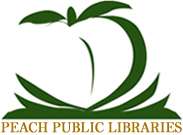Peach Public Libraries
The Peach Public Libraries are a consortium of two public libraries in central Georgia serving Peach County. Its headquarters is the Thomas Public Library, located in Fort Valley, Georgia.
 | |
| Location | Peach County, Georgia, United States |
|---|---|
| Coordinates | 32°33′3.96″N 83°53′0.89″W |
| Collection | |
| Size | 98,369 (2016)[1] |
| Access and use | |
| Circulation | 48,073 (2016)[1] |
| Population served | 27,313 (2016)[1] |
| Members | 8,209 (2016)[1] |
| Other information | |
| Director | Billy Tripp |
| Website | http://www.peach.public.lib.ga.us/ |
| Map | |

| |
PPL is a member of PINES, a program of the Georgia Public Library Service that covers 53 library systems in 143 counties of Georgia.[2] Any resident in a PINES-supported library system has access to the system's collection of 10.6 million books.[3] The library is also serviced by GALILEO, a program of the University System of Georgia which stands for "GeorgiA LIbrary LEarning Online". This program offers residents in supported libraries access to over 100 databases indexing thousands of periodicals and scholarly journals. It also boasts over 10,000 journal titles in full text.[4]
History
The first library in Peach County began in 1878 in Fort Valley, and "housed 2500 volumes of choice and well-selected reading matter. Eight first-class daily papers, numerous weeklies and several standard magazines."[5] While impressive for its time, no other information about this initial library exists today.
The central branch today, the Thomas Public Library, was founded on September 15, 1915 at a members' meeting called by the president of the History Club. By the end of the meeting the Fort Valley Library Association was formed from a donation by Dr. and Mrs. E. G. Thomas, who at the time were lending their 500-volume collection to local friends and patients. The Library Association sought to rent the Evans building in town to store the books, and by September 23 had moved to the new building.[5] The library was initially funded by small $1 per month donations by seventeen citizens of the town, as well as by a $25 per month donation from the local Presbyterian church.
By 1920 the library was growing at a faster pace than the Association could manage. To help lighten the load, a board of trustees was set up in the mid-1920s and a Library Auxiliary was formed by the women members of the library. By the mid-1930s the collection had grown to over seven thousand volumes, and the building proved to be inadequate. The library moved to the recently constructed courthouse in order to fit all its materials.[5]
In 1936, with help from the Works Progress Administration, Byron, Georgia opened their own branch under the supervision of the Thomas Public Library. Upon the end of the WPA this library joined the Thomas Public Library to create the first iteration of the Peach Public Library system. A third library joined the system in 1961 on South Macon Street, but by 1969 was severely damaged by a fire, necessitating the construction of a new building.[5]
On April 16, 1972 the new Thomas Library was formally dedicated by the county. Due to the aftermath of the fire, over $37,000 in funds were raised the townspeople. The county governance provided $80,000, and a lot for the building and additional donations were made by the Governor Lester Maddox for $25,000, and the city government for $35,000.[5]
This library serves a population of over 27,000 people today in Peach County.
Branches
The library system has two branches. The Thomas Public Library is the central branch, located at 315 Martin Luther King Jr. Drive, Fort Valley. There is one branch library, the Byron Public Library, located at 105 Church Street, Byron.
Library systems in neighboring counties
- Middle Georgia Regional Library System to the north
- Houston County Public Library System to the east
- Pine Mountain Regional Library System to the west
References
- "Current Look at Georgia Libraries 2016" (PDF). Archived from the original (PDF) on 8 March 2017. Retrieved 14 April 2017.
- "PINES - About". Retrieved 14 April 2017.
- "PINES Facts" (PDF). Retrieved 14 April 2017.
- "GALILEO - About". Retrieved 14 April 2017.
- Chapter, Treutlen (1972). History of Peach County Georgia. Atlanta, Georgia: Cherokee Publishing Company. pp. 132–134. ISBN 0-87797-023-8.